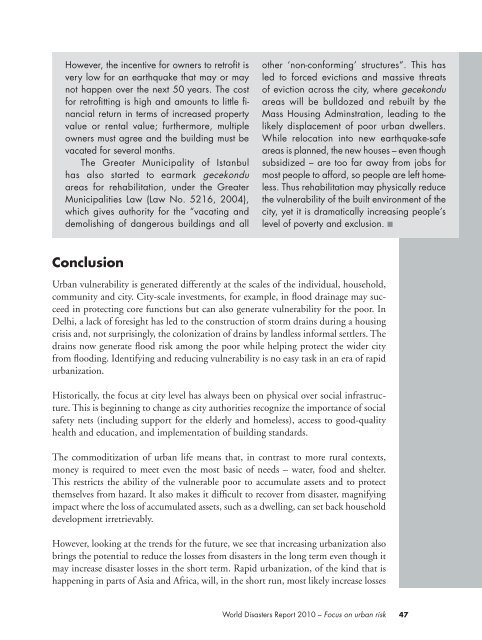World Disasters Report 2010 - International Federation of Red Cross ...
World Disasters Report 2010 - International Federation of Red Cross ...
World Disasters Report 2010 - International Federation of Red Cross ...
You also want an ePaper? Increase the reach of your titles
YUMPU automatically turns print PDFs into web optimized ePapers that Google loves.
However, the incentive for owners to retr<strong>of</strong>it is<br />
very low for an earthquake that may or may<br />
not happen over the next 50 years. The cost<br />
for retr<strong>of</strong>itting is high and amounts to little financial<br />
return in terms <strong>of</strong> increased property<br />
value or rental value; furthermore, multiple<br />
owners must agree and the building must be<br />
vacated for several months.<br />
The Greater Municipality <strong>of</strong> Istanbul<br />
has also started to earmark gecekondu<br />
areas for rehabilitation, under the Greater<br />
Municipalities Law (Law No. 5216, 2004),<br />
which gives authority for the “vacating and<br />
demolishing <strong>of</strong> dangerous buildings and all<br />
Conclusion<br />
other ‘non-conforming’ structures”. This has<br />
led to forced evictions and massive threats<br />
<strong>of</strong> eviction across the city, where gecekondu<br />
areas will be bulldozed and rebuilt by the<br />
Mass Housing Adminstration, leading to the<br />
likely displacement <strong>of</strong> poor urban dwellers.<br />
While relocation into new earthquake-safe<br />
areas is planned, the new houses – even though<br />
subsidized – are too far away from jobs for<br />
most people to afford, so people are left homeless.<br />
Thus rehabilitation may physically reduce<br />
the vulnerability <strong>of</strong> the built environment <strong>of</strong> the<br />
city, yet it is dramatically increasing people’s<br />
level <strong>of</strong> poverty and exclusion. �<br />
Urban vulnerability is generated differently at the scales <strong>of</strong> the individual, household,<br />
community and city. City-scale investments, for example, in flood drainage may succeed<br />
in protecting core functions but can also generate vulnerability for the poor. In<br />
Delhi, a lack <strong>of</strong> foresight has led to the construction <strong>of</strong> storm drains during a housing<br />
crisis and, not surprisingly, the colonization <strong>of</strong> drains by landless informal settlers. The<br />
drains now generate flood risk among the poor while helping protect the wider city<br />
from flooding. Identifying and reducing vulnerability is no easy task in an era <strong>of</strong> rapid<br />
urbanization.<br />
Historically, the focus at city level has always been on physical over social infrastructure.<br />
This is beginning to change as city authorities recognize the importance <strong>of</strong> social<br />
safety nets (including support for the elderly and homeless), access to good-quality<br />
health and education, and implementation <strong>of</strong> building standards.<br />
The commoditization <strong>of</strong> urban life means that, in contrast to more rural contexts,<br />
money is required to meet even the most basic <strong>of</strong> needs – water, food and shelter.<br />
This restricts the ability <strong>of</strong> the vulnerable poor to accumulate assets and to protect<br />
themselves from hazard. It also makes it difficult to recover from disaster, magnifying<br />
impact where the loss <strong>of</strong> accumulated assets, such as a dwelling, can set back household<br />
development irretrievably.<br />
However, looking at the trends for the future, we see that increasing urbanization also<br />
brings the potential to reduce the losses from disasters in the long term even though it<br />
may increase disaster losses in the short term. Rapid urbanization, <strong>of</strong> the kind that is<br />
happening in parts <strong>of</strong> Asia and Africa, will, in the short run, most likely increase losses<br />
<strong>World</strong> <strong>Disasters</strong> <strong>Report</strong> <strong>2010</strong> – Focus on urban risk<br />
47

















